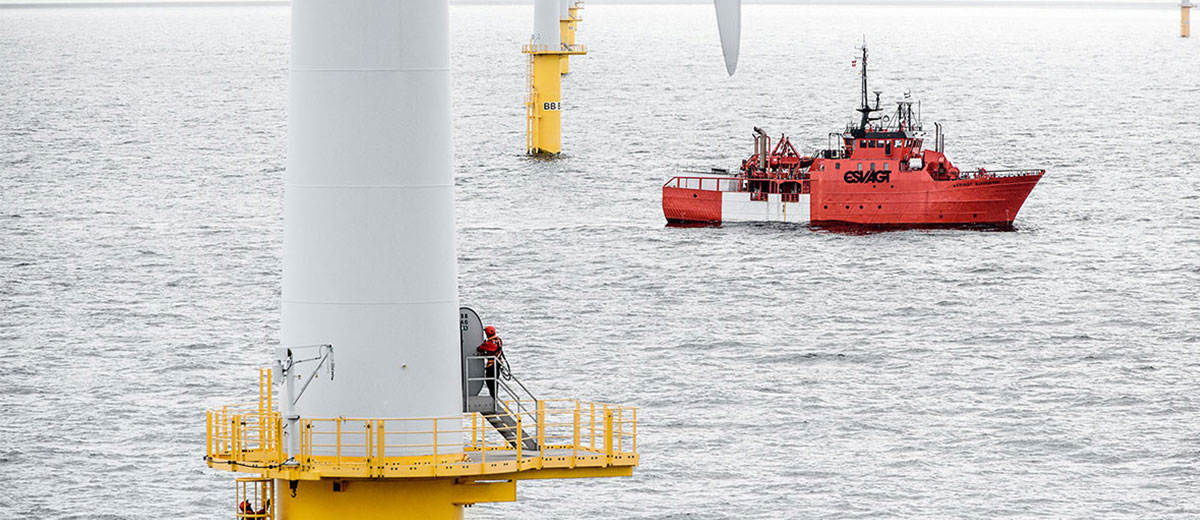With thanks to: Alexia Togelou
How did you become interested in the marine environment?
I became interested in offshore wind as this is currently one of the most exciting, complicated and vital parts of the renewable energy sector future. It involves the simplicity and ever evolving aspect of the wind turbine design with the additional complexity of the marine installation.
What was your entry route?
I studied Electrical Engineering and followed up with an MSc in Sustainable Energy Systems. Following this, I entered a graduate scheme for one of the biggest wind turbine suppliers globally where I developed into a technical project manager.
What are your tasks?
Manage the development of the technical concept of wind farm projects (preliminary foundation & electrical design, marine operation and O&M concept) and manage the identification/screening of different countries for potential new offshore wind farm developments.
What do you enjoy most about your job?
In my job, you can get involved with various different aspects of the technical design of a wind farm with the possibility to dive down into more detail in any of the different aspects if of interest. At the same time, you have exposure and partly drive the commercial aspect of the wind farm development. Finally, offshore wind is still an evolving industry with fairly young workforce full of excitement and will to learn and develop. P.S. Travelling around the world is also nice!
Do you have any tips for someone considering a similar career to yours?
Be flexible in your plans and don’t be disappointed if you don’t get your targeted role immediately. There are multiple ways to develop into such a role so have alternatives. Once you get into the wind industry (directly or via oil & gas or another industry) you have the chance to move around and make changes in your career as you go along

With thanks to: David Edward Weir (Principal Engineer, Wind Energy Technology at Equinor)
How did you become interested in the marine environment?
Offshore wind energy is an exciting field where there is a high pace of technological development and innovation. Social and environmental consequences for offshore wind are less than for most other types of energy production, and with costs dropping as quickly as they are offshore wind has a bright future!
What was your entry route?
I have worked with wind power since getting my degree in atmospheric science in 2008. First as a consultant doing wind resource assessment, then as an adviser in the Norwegian governmental energy authorities where I gained experience with economic aspects of wind energy.
What are your tasks?
Technical and economic aspects of wind project development. Specifically, wind farm layout design; and contributions to wind farm LCOE optimization.
What do you enjoy most about your job?
My job is in a quickly growing and modern industry with a global focus. In the wind industry young people can advance quickly due to the rapid growth and the need for more people.
Do you have any tips for someone considering a similar career to yours?
Get in the door somewhere, even if it involves moving. There is no shortage of wind energy jobs and things are moving quickly – with a bit of experience from the wind industry you’ll quickly become an attractive candidate for many different kinds of jobs.

With thanks to: Bjørn Ivar Vold (Principal Analyst Operations)
How did you become interested in the marine environment?
I became gradually interested. It started with a genuine interest in the energy transition, moving to a renewable future. Then I was introduced to wind energy during my studies and got a genuine interest in the technical challenges and the big energy potential which wind energy offers. From there my interest grew to cover all aspects with wind energy, and especially offshore wind. I now join with great interest discussions on everything from vessel capabilities to commercial power sales discussions.
What was your entry route?
Msc in Technology, Industrial Economics. Master thesis on LCC of floating offshore wind. First job; Research Scientist, Research on eco-efficient utilization of energy and waste resources. Then trainee in Statkraft, Asset Management Offshore Wind.
What are your tasks?
Create a safe workplace that makes sure the turbines spin when it matters to the lowest cost possible. Technical and economic aspects of wind project operations. Specifically, prepare OPEX and wind farm technical availability. Select O&M strategy and set operational requirements to the project. Secure all operational contracts (port, service, vessels, IT systems, people) and establish operational base (people and assets).
What do you enjoy most about your job?
Working with Offshore wind, a global industry rapidly developing, and which have a significant impact on the energy transition, is inspiring and keeps me motivated. Also, I’m lucky to be surrounded by kind, curious and competent people which makes the daily work more enjoyable. Finally, in my role I make well use of my experience and skills in offshore wind and my educational background in finance and engineering which is good for my professional development and the company.
Do you have any tips for someone considering a similar career to yours?
Get your foot in the door either thru an internship, graduate program, summer job or similar and once you’re in, stay curious, be humble and voice your opinion.


























